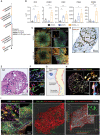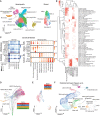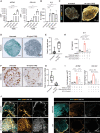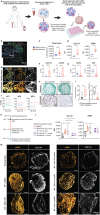Human Bone Marrow Organoids for Disease Modeling, Discovery, and Validation of Therapeutic Targets in Hematologic Malignancies
- PMID: 36351055
- PMCID: PMC9900323
- DOI: 10.1158/2159-8290.CD-22-0199
Human Bone Marrow Organoids for Disease Modeling, Discovery, and Validation of Therapeutic Targets in Hematologic Malignancies
Abstract
A lack of models that recapitulate the complexity of human bone marrow has hampered mechanistic studies of normal and malignant hematopoiesis and the validation of novel therapies. Here, we describe a step-wise, directed-differentiation protocol in which organoids are generated from induced pluripotent stem cells committed to mesenchymal, endothelial, and hematopoietic lineages. These 3D structures capture key features of human bone marrow-stroma, lumen-forming sinusoids, and myeloid cells including proplatelet-forming megakaryocytes. The organoids supported the engraftment and survival of cells from patients with blood malignancies, including cancer types notoriously difficult to maintain ex vivo. Fibrosis of the organoid occurred following TGFβ stimulation and engraftment with myelofibrosis but not healthy donor-derived cells, validating this platform as a powerful tool for studies of malignant cells and their interactions within a human bone marrow-like milieu. This enabling technology is likely to accelerate the discovery and prioritization of novel targets for bone marrow disorders and blood cancers.
Significance: We present a human bone marrow organoid that supports the growth of primary cells from patients with myeloid and lymphoid blood cancers. This model allows for mechanistic studies of blood cancers in the context of their microenvironment and provides a much-needed ex vivo tool for the prioritization of new therapeutics. See related commentary by Derecka and Crispino, p. 263. This article is highlighted in the In This Issue feature, p. 247.
©2022 The Authors; Published by the American Association for Cancer Research.
Figures



![Figure 4. Endothelial, fibroblasts, and MSCs from organoid stroma support hematopoiesis, with increased hematopoietic support from VEGFA + C–stimulated vasculature. A, Comparison of expression of key receptors, adhesion proteins, growth factors and chemokines in endothelial cells from bone marrow organoids (Org) and human fetal bone marrow (FBM). B, Comparison of expression of growth factors and chemokines in MSCs from organoids and FBM. Size of dots represents % of expressing cells and color density indicates level of expression. C, Total predicted ligand–receptor interactions across clusters as predicted by CellPhoneDB (V2.0) showing extensive autocrine and paracrine interactions across BM organoid. D, Volcano plot showing significantly differentially expressed (DE) genes in endothelial cells (ECs) from VEGFA + C vs. VEGFA-only organoids (801 significantly upregulated and 700 significantly downregulated genes, P < 0.05, log2FC > 0.5 or −0.5). E, Violin plots showing key hematopoietic support factors and markers of bone marrow sinusoidal endothelium in ECs of VEGFA + C and VEGFA-only organoids. P values are indicated below x-axis labels, and mean value is indicated on violin plots. ***, P < 0.001; ****, P < 0.0001 for pairwise comparison Wilcox test applied [FDR]). F–H, Sankey plots comparing (F) TGFβ1, (G) CXCL12, and (H) CD44-mediated interactions in VEGFA + C vs. VEGFA-stimulated organoids. I, Expression of interacting receptor–ligand pairs between organoid HSPCs and cognate partner in organoid or FBM ECs (endo) and MSC/fibroblasts, with percentage of expressing cells and level of expression shown. J, Hematopoietic cytokines/growth factors produced by bone marrow organoids, measured by Luminex assay. Each data point represents supernatant pooled from 16 separately generated organoids. See also Supplementary Figs. 4–7.](https://cdn.ncbi.nlm.nih.gov/pmc/blobs/3ef2/9900323/39b80568fbdd/364fig4.gif)



Comment in
-
Bone Marrow Avatars: Mimicking Hematopoiesis in a Dish.Cancer Discov. 2023 Feb 6;13(2):263-265. doi: 10.1158/2159-8290.CD-22-1303. Cancer Discov. 2023. PMID: 36744319
References
Publication types
MeSH terms
Grants and funding
- MC_UU_00029/7/MRC_/Medical Research Council/United Kingdom
- 28051/CRUK_/Cancer Research UK/United Kingdom
- 9609/CRUK_/Cancer Research UK/United Kingdom
- 22658/VAC_/Versus Arthritis/United Kingdom
- R01 HL151494/HL/NHLBI NIH HHS/United States
- FS/IBSRF/20/25039/BHF_/British Heart Foundation/United Kingdom
- 218649/WT_/Wellcome Trust/United Kingdom
- 22710/VAC_/Versus Arthritis/United Kingdom
- R01 DK139341/DK/NIDDK NIH HHS/United States
- MR/W028557/1/MRC_/Medical Research Council/United Kingdom
- MR/W000148/1/MRC_/Medical Research Council/United Kingdom
- 29034/CRUK_/Cancer Research UK/United Kingdom
- R03 DK124746/DK/NIDDK NIH HHS/United States
- MR/R006237/1/MRC_/Medical Research Council/United Kingdom
LinkOut - more resources
Full Text Sources
Other Literature Sources
Molecular Biology Databases

